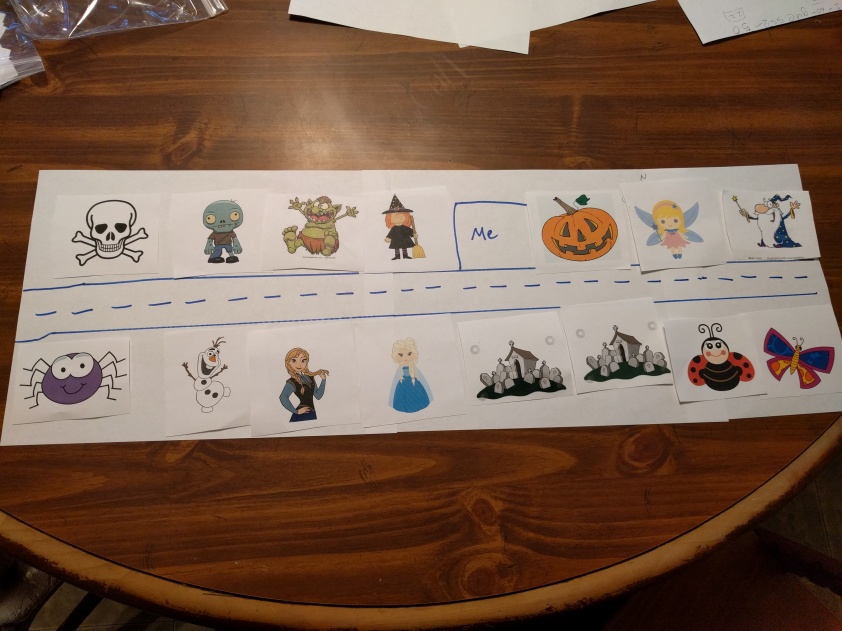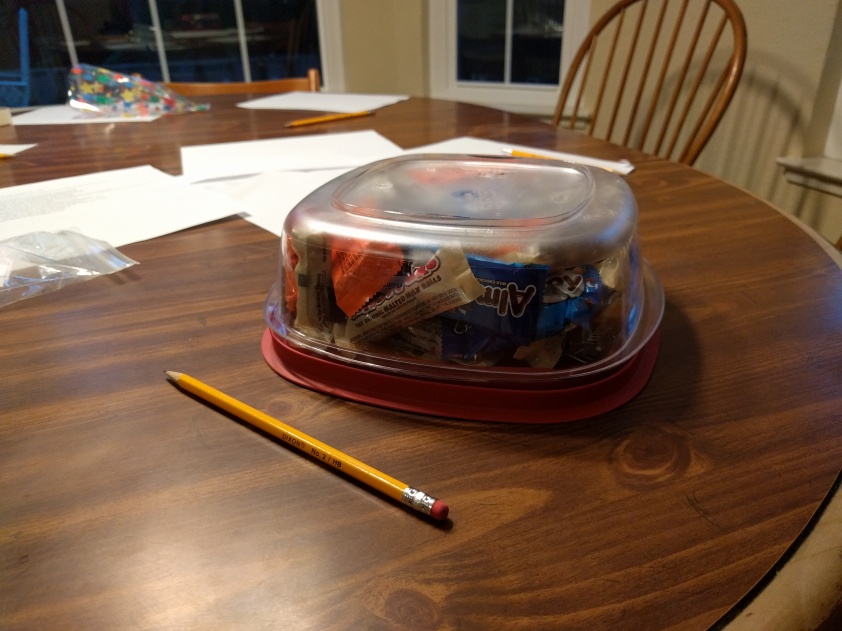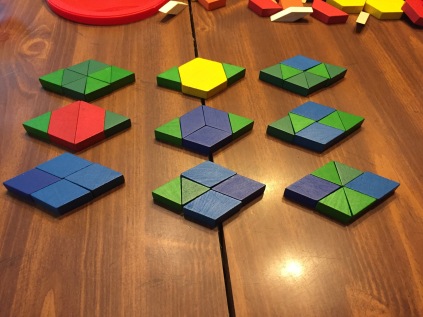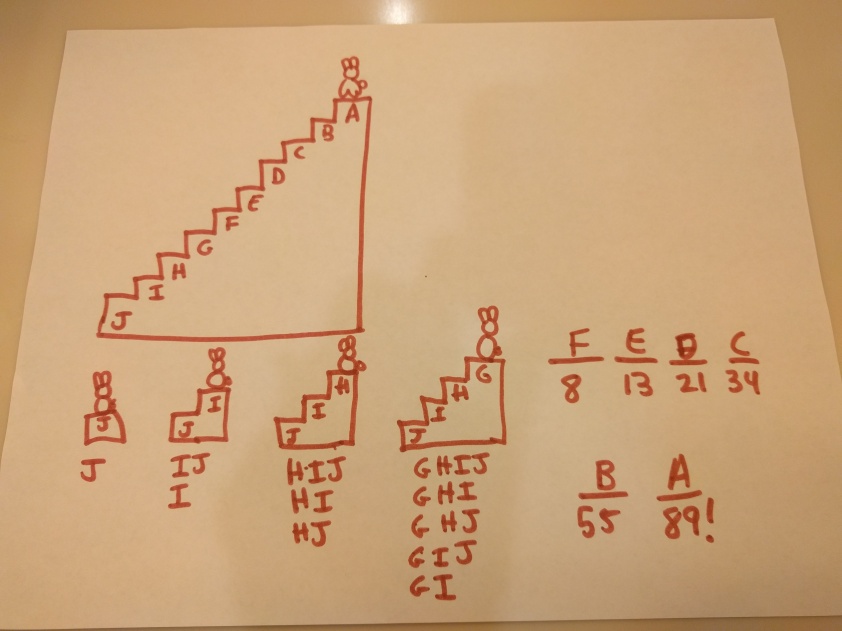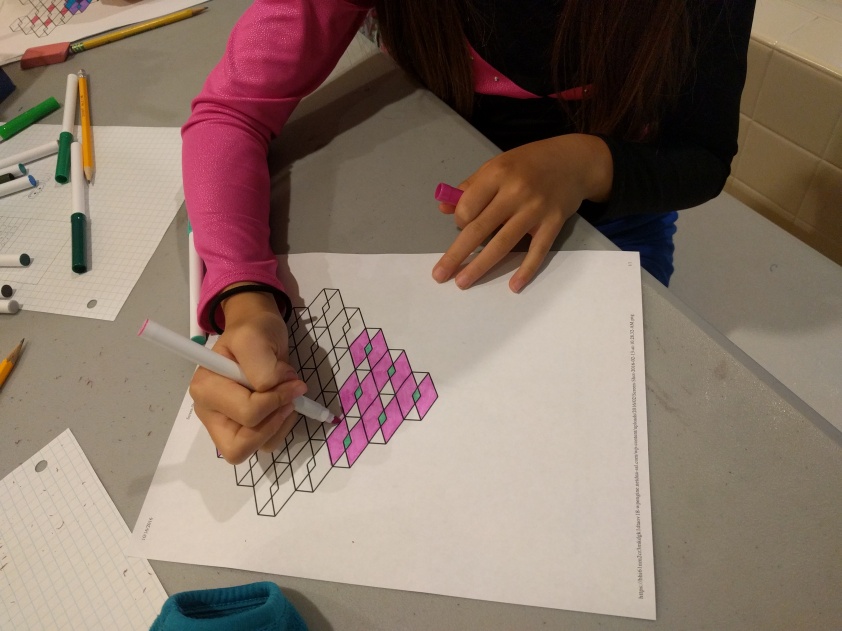The Activities
- Topics: Proofs, Time, Logic: I asked the kids to determine whether or not every year has at least one Friday the 13th.
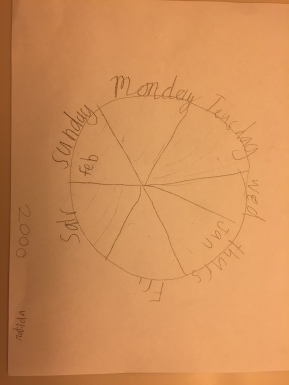
- Topics: Geometry, Time: I made a map of a neighborhood for trick-or-treating. The red house is your house. Each inch of road is one block, and trick-or-treating along one block takes ten minutes. First, I asked them how long it would take to trick-or-treat on every block (this requires repeating a few blocks). Next, I asked what the most number of different blocks you could visit if you had 3 hours. Finally, I asked how many different blocks you could visit if you had to return to your house to drop off candy every 5 blocks (i.e., after 40 houses). A bonus question I didn’t get to was, if you wanted to minimize the time to visit every block, and you didn’t have to start at your house, where should you start?
- Topics: Combinations, Combinatorics, Logic: I had a list of 10 possible trick-or-treaters:
- Evil Queen — Baddie, Girl
- Bride of Frankenstein — Baddie, Girl
- Vampire — Baddie, Boy
- Mummy — Baddie, Boy
- Princess — Goodie, Girl
- Fairy — Goodie, Girl
- Wizard — Goodie, Boy
- King — Goodie, Boy
- Alien — Neither, Neither
- Slime — Neither, Neither
First, I asked how many ways there were to pick three trick-or-treaters. Then I asked how many ways to pick three trick-or-treaters, with the requirement that there’s at least one Baddie, one Goodie, one Boy, and one Girl. Note: Picking groups is much harder than picking ordered line-ups (where Evil Queen, Princess is different from Princess, Evil Queen). If I were doing this again I would stick with ordered line-ups, it’s hard enough already.
How Did It Go?
We had all five kids this week. This was a pretty hard circle; 2 of the kids were engaged through-out, with one saying how they liked the hard problems; the other 3 were distracted a lot of the time.
Friday the 13th
This is a pretty tricky problem, it’s not immediately obvious how to do it even for adults. The kids made some good progress and had some interesting ideas. First, one kid figured out that for there to be a Friday the 13th, the 1st had to be a Sunday. Another kid wrote down the years starting with 2000 (she wanted to check “all the years”). I used my phone to look up the calendars for each year, and we checked which months had a Friday the 13th each year. One kid was really excited to try to find a year with no Friday the 13th, because then they’d be done. But there is indeed a Friday the 13th each year, so we didn’t find one :). At this point, I gave them a hint, which is to draw a pie chart like in the picture above. The idea is to go through an entire year starting with January, assume that the 13th in January is, say, a Sunday, and then figure out what day of the week the 13th is in each month. If you do this, you’ll find that every single piece of the pie is filled, which is what you need to prove that there’s always a Friday the 13th. Unfortunately, the kids were not good at doing the calendar arithmetic to figure out what day of the week Feb 13 is given the day of the week for Jan 13. So, we didn’t get that far, and since we had already spent 25 minutes I moved on to the next activity. Most of the time, two of the kids were working on the problem while the others were drawing, etc.
Trick-or-Treat Optimization
The kids liked the theme of optimizing trick-or-treating. Unfortunately, I made an error in how I set up the problem. My intention was that they should concentrate on how many blocks you’d have to walk, but I drew the houses big enough that they focused on visiting houses instead of walking along blocks. The map I included above I redid afterwards to make it clearer that it’s about blocks, not houses. The problem with houses is that if you have houses on the corners of streets, it makes the counting a lot messier. And counting houses is a bit more intuitive, so that’s what they defaulted to. The result of this was that about half the kids thought I meant that it took 10 minutes to visit three houses, when I actually meant it took 10 minutes to walk one block. All the kids paid attention during this activity.
The kids figured out that you’d have to backtrack or at least revisit some blocks. They were all pretty comfortable with figuring out how long it would take to visit all the blocks, but the idea of the best route wasn’t as compelling. They did understand the idea of visiting as many as possible in 3 hours. The final problem, about returning home each time, isn’t actually that interesting with the map I had, but they still had to think about it some to figure out how to do it.
Picking Trick-or-Treaters
This problem turned out to be harder than I expected. I just forgot that they weren’t that comfortable with combinations yet. Even if I had done the ordered line version, they still didn’t immediately remember how to do the multiplication to figure out the answer to the unconstrained version. They did figure out this part, and we moved on to the constrained version.
I actually gave them a four person version that required 2 baddies instead of 1 — it turns out to be a lot harder than the three person version. Also, the non-ordered version is a lot harder to think about. With the three person version, it’s not so bad to reason along the lines of “Let’s pick the baddy first, and the goody second. For each of the possible combinations (there’s only 4 distinct ones), we can figure out what the third person can be.” The four-person version gets a lot more complicated, so I switched to the three-person version — we made some progress but didn’t solve it.
Again, two of the kids worked hard, while the other three were distracted.
